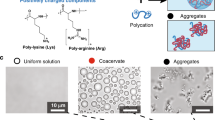Abstract
Cellular ribozymes exhibit catalytic activity in media containing large numbers of anionic compounds and macromolecules. In this study, the RNA cleavage activity of the hammerhead ribozyme induced by Mg2+ was investigated using the solutions containing background nucleic acids, small phosphate and carboxylic acid compounds, and neutral polymers. Analysis of the substrate cleavage kinetics showed that the anionic compounds do not affect the ribozyme activity in Mg2+-saturated solutions and there is almost no effect of the anion–Mg2+ complexes formed. On the other hand, the rate of substrate cleavage in Mg2+-unsaturated solutions was reduced under conditions of a high background of anionic compounds found in cells. The extent of the reduction was more with a greater net negative charge, caused by decreased amounts of Mg2+ that could be used for the ribozyme reaction. It was remarkable that background DNA and RNA molecules having phosphodiester bonds reduced the cleavage rate as much as adenosine monophosphates having a charge of −2 when the effects of the same amount of phosphate groups were compared. Greater reductions in rates than those expected from the molecular charge were also observed in the background of fatty acids that form micelles. An addition of poly(ethylene glycol) to the solutions partially restored the ribozyme activity, suggesting a possible role of macromolecular crowding in counteracting the inhibitory effects of background anions on the ribozyme reaction. The results have biological and practical implications with respect to the effects of molecular environment on the efficiency of ion binding to RNA.






Similar content being viewed by others
References
Record MT Jr, Zhang W, Anderson CF (1998) Adv Protein Chem 51:281–353
Draper DE, Grilley D, Soto AM (2005) Annu Rev Biophys Biomol Struct 34:221–243
Kuhn A, Kellenberger E (1985) J Bacteriol 163:906–912
Bloomfield VA, Crothers DM, Tinoco I Jr (2000) Nucleic acids: structures, properties and functions. University Science Books, CA
Meyers RA (2005) Reviews in cell biology and molecular medicine. Wiley-VCH, Weinheim
Woldringh CL, van Driel R (1999) The eukaryotic perspective: similarities and distinctions between pro- and eukaryotes. American Society for Microbiology, Washington, DC
Ellis RJ (2001) Trends Biochem Sci 26:597–604
Wiggins PM (1990) Microbiol Rev 54:432–449
Grubbs RD (2002) Biometals 15:251–259
Froschauer EM, Kolisek M, Dieterich F, Schweigel M, Schweyen RJ (2004) FEMS Microbiol Lett 237:49–55
Hanna R, Doudna JA (2000) Curr Opin Chem Biol 4:166–170
Bevilacqua PC, Brown TS, Nakano S, Yajima R (2004) Biopolymers 73:90–109
Sigel RK, Pyle AM (2007) Chem Rev 107:97–113
Forster AC, Symons RH (1987) Cell 50:9–16
Bourdeau V, Ferbeyre G, Pageau M, Paquin B, Cedergren R (1999) Nucleic Acids Res 27:4457–4467
Martick M, Horan LH, Noller HF, Scott WG (2008) Nature 454:899–902
Yen L, Svendsen J, Lee JS, Gray JT, Magnier M, Baba T, D’Amato RJ, Mulligan RC (2004) Nature 431:471–476
Citti L, Rainaldi G (2005) Curr Gene Ther 5:11–24
Li S, Nosrati M, Kashani-Sabet M (2008) Methods Mol Biol 405:113–131
Bassi GS, Murchie AI, Walter F, Clegg RM, Lilley DM (1997) EMBO J 16:7481–7489
O’Rear JL, Wang S, Feig AL, Beigelman L, Uhlenbeck OC, Herschlag D (2001) RNA 7:537–545
Penedo JC, Wilson TJ, Jayasena SD, Khvorova A, Lilley DM (2004) RNA 10:880–888
Boots JL, Canny MD, Azimi E, Pardi A (2008) RNA 14:2212–2222
Martick M, Lee TS, York DM, Scott WG (2008) Chem Biol 15:332–342
Lee TS, Lopez CS, Giambasu GM, Martick M, Scott WG, York DM (2008) J Am Chem Soc 130:3053–3064
Chi Y, Martick M, Lares M, Kim R, Scott WG, Kim S (2008) PLoS Biol 6:2060–2068
Zhou HX, Rivas G, Minton AP (2008) Annu Rev Biophys Biomol Struct 37:375–397
Nakano S, Miyoshi D, Sugimoto N (2014) Chem Rev 114:2733–2758
Nakano S, Karimata HT, Kitagawa Y, Sugimoto N (2009) J Am Chem Soc 131:16881–16888
Cantor CR, Schimmel PR (1980) Biophysical chemistry. W. H. Freeman and Co., NY
Nakano S, Proctor DJ, Bevilacqua PC (2001) Biochemistry 40:12022–12038
McElroy WD, Glass B (1951) Phosphorus metabolism. Johns Hopkins University Press, Baltimore
Dawson RMC, Elliott DC, Elliott WH, Jones KM (1959) Data for biochemical research. Clarendon Press, Oxford
Marky LA, Breslauer KJ (1987) Biopolymers 26:1601–1620
Puglisi JD, Tinoco I Jr (1989) Methods Enzymol 180:304–325
Nashimoto M (2000) Eur J Biochem 267:2738–2745
Hsiao C, Tannenbaum E, Van Deusen H, Hershkovitz E, Perng G, Tannenbaum AR, Williams LD (2009) Complexes of nucleic acids with group I and II cations. RSC Publishing, Cambridge
Martel AE, Smith RM (1989) Critical stability constants. Plenum Press, NY
Speight JG (2005) Lange’s handbook of chemistry, 16 edn. McGraw-Hill, NY
Sander C, Ts’o PO (1971) J Mol Biol 55:1–21
Record MT Jr, Lohman ML, De Haseth P (1976) J Mol Biol 107:145–158
Misra VK, Draper DE (1998) Biopolymers 48:113–135
Nakano S, Kirihata T, Sugimoto N (2008) Chem Commun 700–702
Minton AP (1998) Methods Enzymol 295:127–149
Nakano S, Hirayama H, Miyoshi D, Sugimoto N (2012) J Phys Chem B 116:7406–7415
Nakano S, Kitagawa Y, Miyoshi D, Sugimoto N (2014) FEBS Open Bio 4:643–650
Nakano S, Wu L, Oka H, Karimata HT, Kirihata T, Sato Y, Fujii S, Sakai H, Kuwahara M, Sawai H, Sugimoto N (2008) Mol BioSyst 4:579–588
Asami K, Hanai T, Koizumi N (1976) J Membr Biol 28:169–180
Tanizaki S, Clifford J, Connelly BD, Feig M (2008) Biophys J 94:747–759
Cuervo A, Dans PD, Carrascosa JL, Orozco M, Gomila G, Fumagalli L (2014) Proc Natl Acad Sci USA 111:E3624–E3630
Acknowledgments
We thank Akiko Matsuyama and Junpei Ueno for technical assistance. This work was supported in part by Grants-in-Aid for Scientific Research from JSPS (No. 24550200), MEXT-Supported Program for the Strategic Research Foundation at Private Universities, 2009–2014.
Author information
Authors and Affiliations
Corresponding author
Electronic supplementary material
Below is the link to the electronic supplementary material.
Rights and permissions
About this article
Cite this article
Nakano, Si., Kitagawa, Y., Miyoshi, D. et al. Effects of background anionic compounds on the activity of the hammerhead ribozyme in Mg2+-unsaturated solutions. J Biol Inorg Chem 20, 1049–1058 (2015). https://doi.org/10.1007/s00775-015-1286-y
Received:
Accepted:
Published:
Issue Date:
DOI: https://doi.org/10.1007/s00775-015-1286-y




